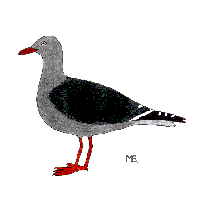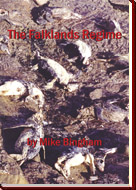 |
 |
| |
|
|
Dolphin Gull Local Name: Red-billed Gull Breeding Range: Falklands & southern
South America Dolphin Gulls are widely distributed around the Falklands coast, but their breeding sites are more restricted. They usually nest in small colonies on sand or shingle beaches, coastal plains or inland near to large ponds. Such colonies are often mixed with other nesting gulls or terns, and as with most gulls they are very sensitive to disturbance. The nest is a simple hollow lined with vegetation, in which 2 to 3 eggs are laid during December. As the chicks mature they form into creches, allowing both parents to collect food. Chicks fledge by March. Dolphin Gulls feed and scavenge on variety of food, from mussels to carrion. They are often seen harassing penguin colonies, but in fact do little harm since they mostly take discarded scraps and excreta. The world population is very small with the majority being in the Falklands. |
|
|
||||||||||||||||||||||||||||




